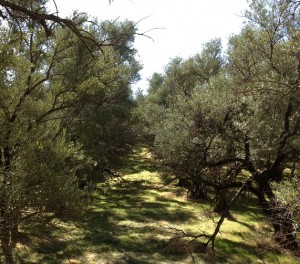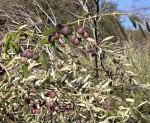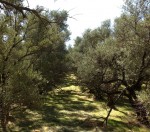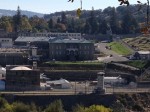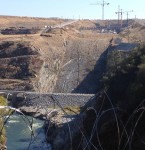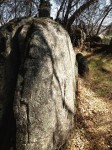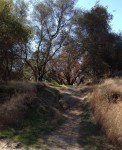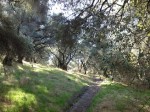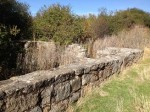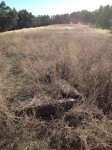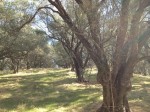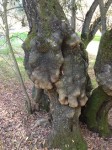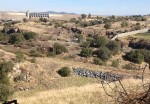The Pioneer Express Trail connected Sacramento to the gold field along the various forks of the American River. 160 years after the trail was formed by numerous leather soles and hoofs, there are still a few remnants left that you can traverse. For me, there is something a little spiritual in walking along a path that so many people used in hopes of finding their fortune.
Small trail of history
While much of the Pioneer Express Trail has been obliterated by roads, homes, dams and general suburban development, there is one little section close to Folsom, CA, that still gives a sense of isolation when you traverse it. It parallels the American River bike path on the east side between Oak Avenue Parkway and the new Folsom Crossing Bridge. I like to run on the trail, but it is great for walking as well. Mountain bikes are not suppose to be on the trail because of its narrow width.
Dry land olives
The highlight for me was running through the old olive orchard. Even though many of the trees have died, a healthy stand of fruit bearing trees still exists. Don’t hesitate to wander off the trail and down the rows of olive trees that create spectacular canopy in some places. Planted over 100 years ago, this Mediterranean native is used to hot climates and little water. The orchard was initially irrigated; you may trip across some of the old irrigation pipe, but it now stands as a testament to the hardiness of the species without any water.
History blocked
You can walk or run right up to the edge of the orchard and look down into the American River Canyon. Your progress is stopped at this point by a fence marking state owned property. I assume access to the river is blocked at this point because Folsom State Prison sits right on the other side of the river. This is unfortunate because it also stop folks from hiking to the remnants of the old Folsom dam.
The first Folsom Dam, constructed with prison labor in 1895, diverted water into a canal to transport logs and ultimately water to the Folsom Power House. The old dam was torn down as the new Folsom Dam was finished in 1955. There are a couple spots off the Pioneer express trail that you can get good look at the old dam structure but the terrain is fairly steep. The canyon is so narrow and steep at this point I would assume that the Bureau of Reclamation would have consider this site for the new Folsom Dam if the prison wouldn’t have been in the way.
Old canals of irrigation
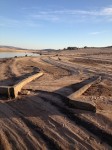
Old irrigation canal normally under the water line of Folsom Lake, that fed water to Baldwin Reservoir and probably the olive orchard.
Also visible is a small levy that must have been built during the construction of the new Folsom Dam and Lake Natoma to keep the little ravine from being inundated with water during high flows on the American River. Before any of the dams were conceived, an irrigation canal, normally under water behind Folsom Dam, supplied water to the area. It was probably this canal, that fed Baldwin Reservoir, and possibly supplied the olive orchard with irrigation water.
Hiding history
At just about a mile in length, the most daunting aspect of this trail is some of the steep grades up the hill side. But if you combine it with a run from Beal’s Point, it is a nice little hike. If you want to actually see the plaque commemorating the trail, you’ll have to hike a little further north of Beal’s Point. In quintessential government fashion, the California State Parks has place the commemorative plaque on a little used path above the bike trail for no one to see.
My next adventure is to harvest some of the olives from the orchard and cure them in brine. We’ll see if this historic dry land farmed olives have any taste.
You may also like a companion blog Curing Olives and the Soul, featuring olives picked from the orchard to be cured.
Click on thumbnail to enlarge.

